 Kent Coast Sea Fishing Compendium |
Float Fishing |
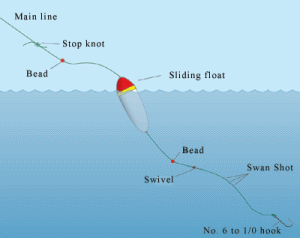
Fishing with a float in the sea is a very effective, fascinating and at times very exciting method for catching a number of marine species.
As you are using much lighter tackle than when bottom fishing, fish are able to show their full fighting ability.
Float fishing is normally practised in depths down to about 30 feet fairly close to the shore, so Deal Pier, harbour walls and deep rock marks (Kingsdown Butts) are ideal for this method.
Although most float fishing is carried out in clear water it can be quite effective in cloudy conditions particularly if the bait is allowed to trail along the bottom.
Tackle
For most situations a light carp rod is suitable but where the target fish are large wrasse and pollack a heavy carp/pike rod may be better to allow for a bit of bullying. The rod length should be 11-13ft as this length makes striking easier and also allows more control of both the float and hard fighting fish. Any reliable medium sized salt water resistant fixed spool reel will suffice. Load it with lines of 10-15lb breaking strain ("B.S."). for general fishing although lighter line of 6-8 lb B.S. may be suitable for shy mullet.
A selection of floats will be necessary to cover all the situations. The size and type of float employed will depend on wave size and depth. Generally the heavier the sea and the greater the depth the larger should be the float. When fishing in calm waters at depths of less than 10 feet it is quite possible to fish with the float fixed to the line. With greater depths a sliding float is the best option.
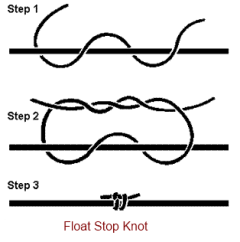
Weights are added to the line to sink the bait. These can be barrel leads, drilled bullets or split shot. Drilled bullets and barrel leads can be held in place with split shot or alternatively a swivel can be used as a stop. Fixed floats can be held in position with float rubbers top and bottom and the weights placed together. These are fine for fishing in light winds. Waggler type floats are more versatile as they can be fished in both calm and windy conditions with the line sunk. Wagglers are fixed bottom end only with most of the shot attached around the bottom ring and enough shot lower down to sink the bait. With sliding floats all weights are usually placed together. With all floats always add enough shot so that just the tip of the float remains above the surface.
It is necessary to use a stop knot when using sliding floats - a piece of thin line, elastic band hitched onto the line or power gum. The important thing about the stop knot is that it allows you to fish at a variety of depths. Whatever is used it should be small enough to pass through the rod rings fairly easily and not interfere with casting significantly when it is wound onto the spool of the reel.
The stop knot should be secure and tight but allow you to move it if needed. If you are not catching then try varying the depth. Some sliding floats have fairly large holes for the line to pass through and these can also allow the stop knot to pass through. This problem can be overcome by using a bead on the line between the float and the stop knot.
I would recommend 10-12ft depth from stop knot to hook. I usually fish deeper at the beginning of the year and then "shallow up" to about 10ft in the summer.
Hook size and pattern will depend on the bait. All types of bait are worth trying especially live ones such as prawns, shrimps and sandeels.
Technique
When float fishing the depth at which the bait is held by the float is often critical to success. And don't forget when fishing near the bottom that the float has to be constantly altered with the tide. Quite often, bites will cease but when the float is reset to the correct depth, bites will start again proving the importance of fishing at the correct depth. When fishing near the bottom start by setting the float so the bait is held about 1 metre above the bottom. The depth is set by adding a weight to the hook which is large enough to sink the float. The stop knot is then moved until the float can be seen a metre below the surface. The depth can be adjusted until you start getting bites.
When fishing for mid water species such as mackerel, scad and garfish it is best to set the float at about 10 to 12 feet to start with. Garfish can be very shallow and are often in the first 6 feet.
Normally some or all of the weight will be fixed about 15 - 30 inches from the hook so as to get the bait down quickly; however, fish sometimes respond to a bait that slowly sinks through the water. Many continental anglers fish with all the weight just below the float for species such as bream and mullet. When fishing "on the drop" in 6 feet of water or less then it makes sense to place all the weight directly below the float but in most situations it is only necessary to move the weight away from the hook towards the float. The bait will fall through a depth equivalent to twice the distance between the hook and the weight.
About 23 species can be caught when float fishing including sea trout, cod, dogfish, grey gurnard, wrasse, pollack, coalfish, mackerel, scad, garfish, bass and mullet.
Tips
- Use a float which will just remain above the waves or just support enough shot to carry the bait down when fishing in calm water.
- Ground bait can be very effective when float fishing, but make sure you are baiting the area you are fishing otherwise you will be attracting the fish away from you.
- Sometimes fish like pollack and wrasse will not be spread evenly around the area you are fishing but will be found in one particular spot.
- Quite often fish spot the bait and come over to investigate, so re-casting often produces a bite.
- In a similar way fishing a slow sinking bait can prove irresistible to some fish.
- When fishing very rough ground use a weaker hook length which will break before the main line saving your float and weights. Join the hook length and main line to a swivel and place your weights above.
- If you find your hook length lays across the float and tangles the main line when you cast, add a split shot above the weights so that when the bait swings towards the float the float is held away from it so it can't reach it.

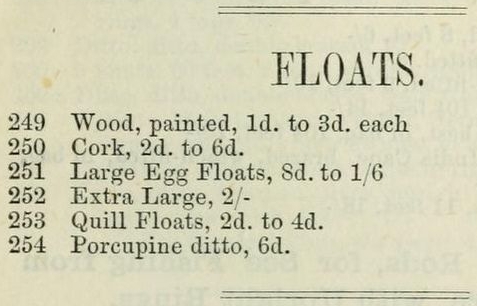
Floats
"Guide to Sea Fishing and the rivers of south Devon and descriptive catalogue of their prize river and sea fishing tackle, cricket, archery, croquet, umbrellas, parasols &c" (1875 - 7th edition, first published 1800) J. N. Hearder & Son at page 23
"Tank Angling in India" (1887) Henry Sullivan Thomas at pages 23 to 28
Chapter I
Paste Baiting
In order to be able to see the critical second for striking, your float must be most sensitive. A porcupine quill is all too coarse an implement. The natives use a 4 to 6 inch piece of the stalk of a large grass and, laying the running line on it, whip a little cotton round both, close up to one end of the float. The float is thus attached to the line, and the line will, with a little persuasion, run up and down under the whipping if you wish to alter your depth, but the friction is enough to keep it from doing so itself. At least the friction of the whipping is supposed to be enough for this purpose, but I have found it sometimes fail me after the float and line have become sodden from being some time in the water, and little by little the depth alters, which is fatal to good fishing, for as we shall see hereafter the depth must be exact.
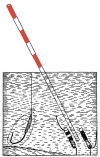
I have therefore slightly modified the native float. I take a long tail feather of a peacock and cut off the quill part till we get to the solid pithy opaque white stem. The part of this stem which is nearest the bird is a trifle thicker than the rest which tapers gradually. I used, at one time, to use the thicker end as well as the rest, and that poaching son of Holy St. Dennis does so still and prefers a 5 inch length of it, but after very close comparison of wary bites I am convinced he is wrong, and that it is not by any means an immaterial point that I can leave to the angler's fancy. I am convinced that in wary biting the thicker stem will not be so sensitive and indicative as the thinner. I therefore cut off and throw away as much of the stem as is more than ³/₁₆ths of an inch [3] in width, and then I cut the rest in 6 inch lengths till the stem gets to less than ²/₁₆ths of an inch [4] in width, when it becomes too thin and frail to stand much use.
The stem of the peacock's quill is not round but slightly oval, and the above measurements are taken across the broadest part of the oval. It is easily done with a compass or gauge screwed to the right gape. The thicker part of the quill is only ¹/₁₆th or ²/₁₆ths of an inch [5] thicker, and you may think I am mighty particular. I am, but intentionally, because I think it will add to your sport. One of the peacock tail-feather quills is 4 or 5 ft long, and you will only get 2 or 3 of my 6 inch floats out of it, whereas you might cut 6 or 7 out of one quill if you are not particular. But the quills are not expensive. You may get a bundle of 18 or 20 for 4 annas.
Remove the harl, not by stripping as it tears off the shiny skin of the stem, but by neatly snipping. The float will not then get so readily sodden in the water.
Then to one end, the thinner end for preference, a small loop of thick salmon running line is whipped on so as to project a quarter of an inch by outside measurement, and dipped in varnish to stiffen it. I tried a wire loop first but I found it cut the line. This loop or eye is for attaching your float to the line, and it forms the bottom end of the float as it stands in the water.
Then we commence work on the top of the float. The surface of the very end where it has been cut is left white to attract the eye, but all round the float for half an inch down is painted bright vermillion in oil colour. Then half an inch of float is left the natural white, and the third half inch painted again a band of bright vermillion. Then there is another half-inch band left white, and the next half-inch band is painted vermillion, and the rest of the float is left its natural white. Thus we have the very tip white, followed by alternate half-inch bands of vermillion and white, till we have three vermillion bands, which is enough, as the float rides in the water with most of the white unbanded part submerged.
The object of the alternate red and white bands is to aid your eye in detecting such slight depressions of the float as would otherwise be imperceptible, and you will find occasions when the little white tip will prove invaluable. But you will understand these difficulties when we come to discussing the manner of biting. For the present we are getting the tackle ready.
In the Frontispiece there is a break in the float because my page will not allow me to make it the full 6 inches.
You will observe that in the drawing, Plate I, the float is represented as riding with a slight tilt on it, and not perfectly upright. The reason for this is that in that position the slightest tension from the fish sucking at your bait makes the float stand upright, which is a larger movement than a slight depression, and catches your eye more quickly. Of the fishermen that I have seen at this work the most successful prefer this tilt, but some on the other hand prefer an upright float. You are graciously permitted to do as you like, now that I have duly warned you of the advantage gained by the tilt. Still, I only recommend a slight tilt as in the diagram. The thing may be overdone.
You will see again that this float, which I will call The Detective, differs from the English floats ordinarily used for roach in having the line attached to one end only. The upper end is thus left perfectly free, and is consequently much more sensitive than if it was weighted with a heavy sodden piece of running line dangling from it into the water; and when you gather up your line in preparedness for a strike you do not affect the float so much as if the line was fastened at the top also. In short, there is no rhyme or reason in fastening the line to both ends of the float, one end is quite enough to prevent your losing your float, and for detective purposes much better.
And then why do I use a loop instead of the simpler English sliding cap. Because the loop is at the very end of the float, whereas a cap necessarily slips up more or less till it bites tight, and in the former case you get the indication of the bite magnified by the leverage of the length of the float, a leverage which is again increased by having the float 6 inches long in preference to 5. This may seem a very trifle, but wait till you have seen the bites for yourself. Wait till you have sat, as I have, for a whole day watching a float and complaining that nothing but minnows or the like were biting, little bits of wretches that were only made for the purpose of stealing your bait and were not worth catching, wait till you have done this and, in consequence, caught nothing, whereas you might have caught a cooly load or two of fish running from 1 to 6 or 7 lbs and more, wait till you have done this and see if you do not agree with me that no pains should be spared in making your float as sensitive as possible for the detection of these sons of thieves, Labeos, and White Carp.
I have then a loop of varnished salmon running line at the bottom of the float, and the way in which the float is put on is simplicity itself. Double the running line at about the place where you wish to have your float, pass the doubled end through the loop or eye at the end of the float, and drawing enough through, pass the loop thus formed in the running line over the float, and bring it down, and pull it as shewn in the diagram. It will never slip in the least.
If you want to change your depth the knot must be loosened and the upper or lower end pulled according as you wish your length below the float less or more.
This loosening of the knot is considered troublesome by some, and it is also objected that in picking open the knot which gets very tight from striking and playing big fish, the running line is liable to get frayed and weakened at that point. There may be something in the objection, but there is not much to my thinking, and I prefer this simple knot on the whole for the main reason that it never slips, and once having got my depth with the greatest exactitude to my complete satisfaction I know I can keep it without the slightest alteration all the day, or for a week for that matter, unless I get a hook or line carried away earlier. But quot homines tot sententiæ, [6] and some consider the slackening and shifting of the knot a nuisance. For them I substitute the alternative plan also shewn in the diagram. It is this:
Make a quill cap which shall fit the float tight close down to the loop end. The cap must be whipped round to prevent its splitting when forced on tightly. Before knotting your running line on to your hook gut, pass the running line through the eye of the float and through the cap, and push the cap into position on the float, pushing it from the loop end upwards, not from the top end downwards as in an English float. Then tie your hook gut to the running line, put on your sinker, and proceed to find the depth at which to fish. For the temporary purpose of finding the bottom, the cap is easily slipped off and on at the lower end of the float, and bites enough to prevent shifting then. But when you have your depth to a nicety, and want to be assured of no change taking place from slipping, I don't think the bite of the cap is quite assurance enough, and I add to it the following simple precaution, shewn in the diagram: slip the cap down and off the float at the lower or loop end, taking care that in doing it the line does not shift in the slightest degree, and holding the loop or eye in the float so that the lower or hook end of the line shall not shift, pass the upper or rod end of the running line three times round the outside of the float loop, as if you were whipping or binding it, then lay it on the float and pass the cap over it. It cannot shift in the least.
You will please observe that in this plan, as well as in the previous one without a cap, the principle is carefully preserved of keeping one only point of attachment of the line to the float close down to the lower end, the upper end being quite free, and that the point of connection with the fish's bite is the extreme lowest end, so that you may have the advantage of preserving all the leverage the six-inch float can give you in indicating bites. On no account let the cap come any way up the float, or you weight the top with the line and interfere with its freedom and indicativeness.
There is one little objection to this latter method. The float is made of frail material, and will not bear much pushing on and off of the cap, and unless very carefully handled is prone to double up when sodden. But in no case can such very light material be very durable, and such floats can never be very expensive to make. I keep them ready by the dozen but then, it is true, I have to do the same with all tackle, as my friends, long may they do it, have a way of using my tackle and breaking or losing it for me at a grand rate. "It is well I have a good supply" I said one day rejoicingly, as fish were carrying away hook after hook, and now and then a float. "Yes it is" said my cheery friend, as he helped himself again out of my box, and it would never do for you to run short".
It is therefore an open question which of the two styles of float you use, a matter of personal preference. I think tackle shops should always buy them thus, for then he always leaves himself the option of throwing away the cap and using the loop only, if he finds he prefers it.
Now for the hook …
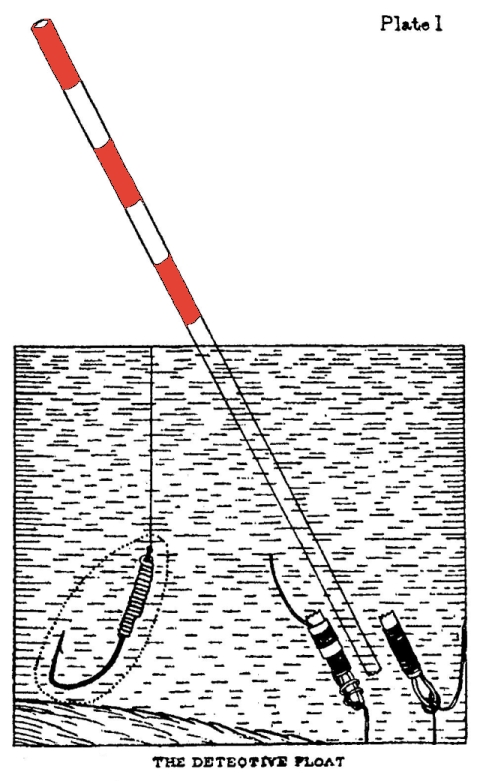
[3] Editor's note: the text actually stipulates two and a half sixteenths but there is no ASCII code for this unusual fraction. However, it is possible to use ASCII code to compile the alternate five thirty-seconds: ⁵/₃₂
[4] Editor's note: the quality of my copy of this text is poor so this is an educated guess. Although it begs the question, why did the author not stipulate one eighth (⅛) …
[5] Editor's note: the text actually stipulates one and a half sixteenths but, again, there is no ASCII code for this unusual fraction. However, it is possible to use ASCII code to compile the alternate three thirty-seconds: ³/₃₂
[6] Editor's note: quot homines tot sententiæ translates from the Latin as "there are as many opinions as there are men".
"Angling in Salt Water: A Practical Work on Sea Fishing with Rod and Line from the Shore, Piers, Jetties, Rocks and from Boats" (1887) John Bickerdyke at pages 26, 27 & 28
Float Tackle
This I may divide into two kinds - heavy and light; the former for use in the sea, the latter for harbour fishing. For fishing in the open sea, from piers etc the best form of float is one similar to those used by jack fishers - pear-shaped, with a hole drilled down the centre, through which the line passes … If the sea is quite calm, a smaller float may be used - for instance, the favourite one of Nottingham anglers, a large quill …
Light float tackle should be very similar to that used for roach. It is used in harbours for small whiting, rock-fish, bass, mullet, and for flounders and smelts. Any small float will do, those long and tapered being best …
… For very deep water float tackle cannot be used unless the float slides down the line when a fish is hauled up, to allow the line to be brought through the rod ring on to the reel. This is easily managed with a float having a hole through its centre like an ordinary pike float, or fitted with small rings through which the line is led. A piece of india-rubber band is tied on the line at the point where the float is to rest. This fragment of rubber, while not passing through the float, goes easily through the rod rings when the line is wound up.
"Hints and Wrinkles on Sea Fishing" (1894) "Ichthyosaurus" (A. Baines & Frederick George Aflalo) at pages 67 & 68
Methods of Sea Fishing
Float fishing is a most sportsmanlike, and also a very killing, method of taking bass, pollack, mullet and other varieties of fish. As with the driftline, one hook only should be used. A good sea float has yet to astonish the market, as most of the existing patterns bob too freely with the dancing of the waves.
There are two conditions of equilibrium in such a float, it should be long and properly balanced with sufficient lead.
The lower portion should be dull green or blue, the upper belt white, which has the advantage of being conspicuous after dusk and in the moonlight. Of course, it should be of cork. Some float fishers, notably on the Cornish coast, use leaded floats on the self-cocking principle, which cannot, however, be recommended, as a little additional lead is sufficient to submerge them.
The Fishing Gazette float is a fairly stable article, but with the floats at present in the market, this kind of fishing, so deadly just on the flood tide, can only be practised on the calmest days. Then, indeed, the angler can send out his bait to search all the water for fifty yards round, and at every depth; and for mullet, pollack, bass, mackerel and coal-fish there is no more killing method. The angler should not strike until the float is well under.
"Practical Letters to Young Sea Fishers" (1898) John Bickerdyke at page 181
When fishing with a rod in rather shallow water, such as one finds round rocks and at the mouths of harbours, float tackle is often serviceable - particularly when the tide is very slack … This tackle is so extremely simple that it does not require illustrating. Place a pipe-lead, or a Jardine lead, from half an ounce to an ounce, at the end of the line, and beneath this 2yds of gut and a hook. On the hook may be a piece of sand eel, or a strip of mackerel skin, or a couple of live rag worms. The distance between the float and the lead will depend on the depth of the water. For pollack and bass the bait should swim at about mid-water, or a little lower, while for mackerel it should be generally nearer the surface. These fish sometimes feed close to the bottom. In roughish water the float is not so much used, because it cannot be seen …
"Dover as a Sea-Angling Centre" (1900) Deputy Surgeon-General Charles Thomas Paske at pages 40 & 41
Chapter V
… The salmon of the sea, as the bass is often called, may likewise pass that way in search of delicacies … With such a probability dangling before the eyes of the ambitious disciple of Walton, he may devote an evening to this noble and very powerful fish. In this case stronger all round tackle and a different modus operandi will be necessary. A large float with about 4 feet of strong twisted gut below and a bunch of rock worms, squid, the head of a plaice, or mouthful of "good red-herring" attached to the hook, may be allowed to wander about in various directions, now alongside the Jetty, anon further afield.
Size for size, the bass represents one of the most powerful, gamey fish a man is likely to encounter. He tugs at the line in a manner simply alarming, bends the rod to its utmost capacity and fights to the bitter end. Plenty of time he wants and will have. Yield to him; hurry him not and in the end he will succumb. Bear in mind, too, his formidable armature when lying at your feet vanquished, for even in his death struggle he is capable of inflicting very nasty and somewhat dangerous wounds, those being inflicted by his spiny dorsal fin, gill covers as sharp as lancets and teeth studding his mouth …
"Sea Fishing for Amateurs: a Practical Book on Fishing from Shore, Rocks, or Piers" (1904 - second edition) Frank Hudson at pages 36 & 37
Pollacking from piers and rocks is a capital amusement, but requires some knowledge and skill. Use a fine reel line, to the end of which attach a single gut cast of about 1 yard in length.

A "Pennell" Limerick hook, size No. 11, is the best … Weight the gut with two or three small shot, or lead wire, but when there is no current you may use a light line. Bait your hook with rag-worms, so as to leave two or three tails hanging down, and the livelier your worms are the better. Separate any pieces from the main stock of worms and keep them in another tin. These portions will do very well for pout, chads, smelts, &c, but pollack much prefer live bait. A float is often desirable, and Fig. 31 shows an excellent kind, known as the "Fishing Gazette" float. There is a slit in the side through which to pass the line before pegging it, and this can be taken off at a moment's notice. In angling from rocks, allow the current to carry your float some distance out to sea; you will thus stand a better chance of hooking a good fish. The length of line below the float will depend upon circumstances and the depth of water. Try different depths for pollack. Always have sufficient lead on your line to keep the float submerged as far as the light-coloured portion, and upright in the water.
"Practical Sea-Fishing: A Handbook for Sea Anglers" (1905) P. L. Haslope at pages 42 & 43
Chapter IV. Rods, Reels and Tackle
Floats
For boat-fishing it is seldom necessary to employ a float; but from piers or rocks it is sometimes useful to keep the line in deeper water. Fig. 29 represents the "Fishing Gazette" float complete, before inserting the line. Remove the wooden peg, and pass the line through the slit, replacing it firmly after this operation. The advantage of this float is that it may be quickly adjusted without having to disconnect the trace. A porcupine quill float may also be used, which may be easily attached by passing a couple of half-hitches over the top and bottom of the peg; or by means of the rings in the ordinary way. Those of a rounded form are to be preferred in rough weather as they ride better over the waves. Luminous floats are now sold, and for evening fishing they offer special advantages. Fig. 30 shows the Slider float, a useful pattern for fishing in deep water, and sometimes used for boat-fishing. As its name implies, it travels up and down the line, so that, when the latter is drawn in, it rests upon the shot or weight lower down; but, when cast out, rises again to the surface of the water. A stop (B), consisting of a piece of gut or rubber band, must be tied on the line according to the depth the angler requires to fish. It is most important to arrange the weight so that the float will ride perpendicularly on the water, and not flat upon the surface.
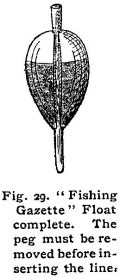 |
 |
"Sea Fishing" (1911) Charles Owen Minchin at page 274
Chapter XVIII
Tackle for Angling
… A large float, made on the "release principle", which will support 2oz comfortably, often comes in useful and enables one to fish at midwater with one rod and at the bottom with another.
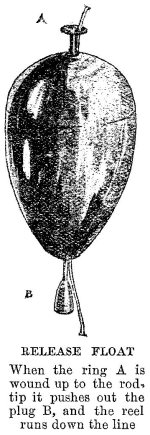
"Sea-Fishing from the Shore" (1940) A. R. Harris Cass M.B.E. at pages 78 to 87
Chapter VIII
When to use Float Tackle
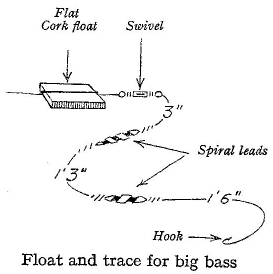
If a heavy sea is running, with big waves pounding the beach, bringing with them a mixture of all kinds of weed, to keep a lead well out is almost an impossibility, while a bite would probably go unnoticed amongst the incessant jars caused by ribbon weed attached to stones constantly fouling the line. At such a time fishing with ordinary weighted tackle is calculated to fray the temper of even the most patient angler, for no sooner is the cast completed, and the line reeled taut, than the strong current and the floating debris bring in the bait. But this is the right moment to change over to float tackle, as now the really big bass are on the prowl, seeking those choice treasures which the tumbling waves stir out of the sands.
Resource should be made, if possible, to stouter tackle; line and trace of a greater breaking strain, and a larger hook, for should a bass favour your bait, you may be certain that your catch in this boisterous sea will, on the law of averages, be something heavier than five pounds; more likely a fish of eight or ten pounds in weight will have to be coaxed ashore; and not merely with a fighting fish will you have to contend, but with the enormous pull of the waves aided by any weed your float, swivel and leads have appropriated …
The bait suitable for this class of fishing is a "snead" or strip of mackerel, or of one of its alternatives referred to in the chapter headed "Bait"; the idea being to suggest a small silvery fish flashing about in the rising and falling waters.
Now, where to place your lure. There is no necessity to make a long cast, as the bass are close in when you are trying with this tackle. Looking out to sea you observe the waves come sweeping in until finally the last one crashes not far from you. Behind this mighty roller is where you must drop your bait, not too close to the climbing wave or the float will be washed in, but just far enough away so that the undertow can neutralize the flowing water. If your first attempt at this mark is not successful, do not hesitate to reel in and cast again, for anywhere but in the right spot is courting failure in your efforts to account for that specimen.
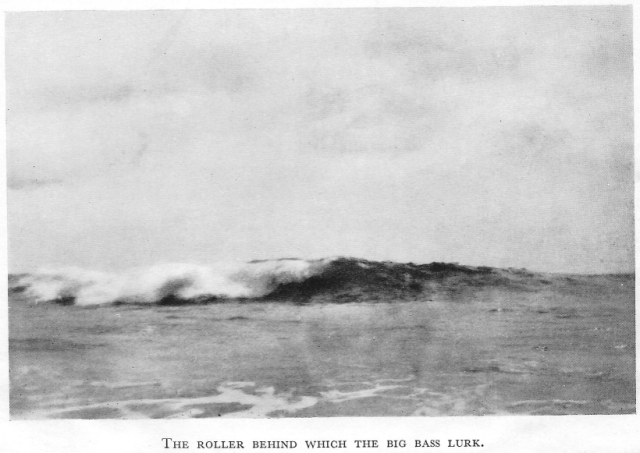
This type of tackle, but of a lighter description, can be employed with every prospect of good results on calmer days, if you can find a suitable position on a rocky ledge jutting out from the shore and where, by casting out either to the left or right of the point, the current will carry your float away from you. Any of the baits previously mentioned may be used for this kind of angling. One spiral lead, however, will prove adequate, and it should be attached about half-way down the cast …
Before finishing with this interesting method of angling, and the very important part that it plays in dealing with the fish that visit these estuarian waters, mention must be made of that shy fish, the grey mullet. Probably there is no more tantalizing sight than to see hundreds and hundreds of these fish, in vast shoals, calmly swimming round and round, utterly indifferent to the well-baited hooks that bar their passage … Our success was always attained when the water was at its lowest level, and we decided that the solution of the mystery was to be found in the state of the water. Grey mullet are notoriously partial to estuaries and harbours where the taint of sewage exists, hence at low tide the "seasoning" would be more piquant.
Of the many varieties of baits employed, none equalled the killing qualities of the small ragworm used in conjunction with exceedingly light tackle.
"Approach to Angling in Fresh and Sea-Water" (1950) E. Marshall-Hardy and Lieut. N. Vaughan Olver, R.N.V.S.R. at pages 207 & 208
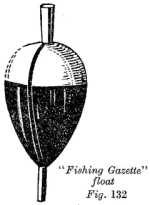
Section IV: Sea Fishing from Jetty, Pier or Shore
Chapter IV
The Seaside Native on a Rocky Coast
Float Fishing
During a rough sea, or just after stormy weather is a good time to fish for large bass.
A large "Fishing Gazette" type float is perhaps the most satisfactory for this kind of rough sea fishing, when the fish are feeding right in the surf.
"Bass: How to Catch Them" (1955) Alan Young at pages 29 to 33 & 65 to 71
Chapter II
Tackle
Floats
… Three types of float are desirable:
- a slider float,
- a float for fishing choppy water at depths not greater than the length of the rod,
- a very light float for fishing calm, clear water.
It is also desirable to have (1) and (2) in each of two or three different sizes for use with different weights.
No. 2 can be dispensed with and a slider float used instead, but for depths of less than 8ft or so I prefer the more reliable fixed floats.
One principle that governs all types of float fishing is that the float should be buoyant enough to support the weight of the lead, line, hook and bait beneath it without sinking so far as to make it difficult to see; and at the same time it should be sufficiently weighted to go under with the slightest pull, so that a fish is not frightened off by undue resistance caused by buoyancy. This may not be very important in troubled waters where a bass is likely to come at the bait with a dash and hook itself, but no harm is done by having a well-balanced float even in these circumstances.
Slider Floats
A slider float consists of a float with two standoff rings through which the line can run easily. A stop is made 3 or 4 feet above the bait. A swivel too large to pass through the float rings serves this purpose. This is to prevent the float sliding right down to the hook when a fish is being landed or when the tackle is withdrawn from the water.

When the depth at which it is desired to fish has been ascertained, a stop is put on the line the required distance above the hook, between the float and the rod. When the tackle is lowered into the water the hook and weight sink. The float runs up the line at the surface of the water until it meets the stop, beyond which it cannot pass. Here it remains, supporting the baited hook at the required depth.
The upper stop is important. It must be large enough to prevent the float from passing it and small or supple enough to go through the rod rings. A common stop is made by fastening a small length of valve rubber to the line by a hitch. I do not like hitches in lines, and I have recently come across an alternative which I think an improvement. As soon as the line is threaded through the rod rings the end is threaded, with a needle, through a short length of valve rubber and brought out half-way down the rubber (Fig. 8). The float is then put on the line and the trace, etc., tied on. By forcing a short length of pared matchstick into the upper portion of the valve rubber it is possible to fix it as a firm stop on any type of line at any required position. This may seem elaborate, but once the stop has been threaded on the line it can stay there, being wound on to the reel when fishing is over. Fig. 8 shows a 1in length. This can be shortened or lengthened to match rod-ring diameter.

Nearly all the sliding floats I have seen on sale have a short projection at the top. This would seem to be a convention brought from freshwater floats, but it serves no useful purpose in sea fishing. The top of the float should be fairly thick and rounded so that it can be seen in choppy water, but the half inch or so of projecting wood is merely a nuisance, for it is liable to get twisted up with the line. I make the type of float illustrated (Fig. 9) from cork or balsa wood. The rings are of twisted copper or brass wire.
Fixed Floats
When fishing at depths less than the length of the rod I find a Fishing Gazette ideal. [2] This float is made with a slot cut down its length. A peg occupies the "core" of the float. When the peg is withdrawn the line is put through the slot and the peg reinserted. Thus the depth can be adjusted in a moment, or the float can be removed altogether without disturbing the rest of the tackle if the angler wishes to try drift lining or some other method of floatless fishing.
Light Floats
These are for use in clear, calm water, particularly in the lee of rocks. It is essential that tackle should be unobtrusive, and since the float has in these circumstances only to support two or three split shot as weight, a 3 or 4in porcupine quill is sufficient.
[2] Editor's note: two examples of Fishing Gazette floats:
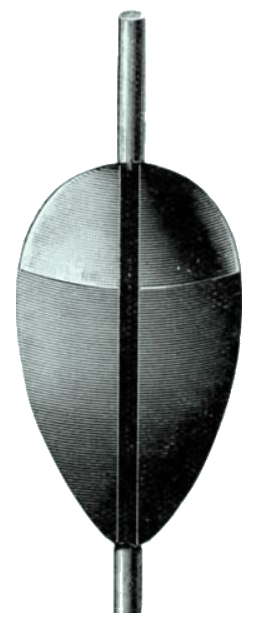 |
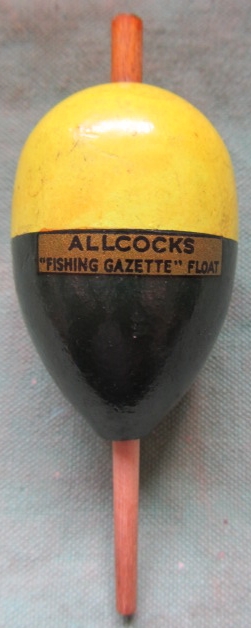 |
Chapter IV
Methods
Float Fishing
Before passing on to a detailed discussion of float fishing from various positions I will summarize these advantages.
- Float fishing (with a slider float) will enable the bait to be fished at any required distance from the bottom.
- Over rocks and weeds the float supports the bait when paternoster or ledger tackle would almost certainly be fouled.
- Calm, clear water, scarcely fishable by any other method, can be fished with light float tackle with every hope of success, providing the angler keeps out of sight.
- Bass feeding in sub-surface to middle-depth waters can be presented with baits in currents too strong for successful drift lining.
- Float fishing from projections enables the bait, at the required depth for the circumstances, to be kept close to the piles or walls where it is likely to be among the bass.
Depth
In all forms of float fishing the bait is fished at a known depth (in sub-surface fishing) or at a known height above the bottom (in deep-water fishing).
Finding the depth at which bass are feeding is not an easy matter. Anglers who know the local waters well can often deduce the level at which the fish are feeding from the hour of the day, the state of the tide, etc.
Without such knowledge an angler must work on trial and error methods. It can generally be said that a proportion of the bass in any vicinity will be feeding near the bottom, so "just off the bottom" fishing usually produces some result if bass are about at all.
The method is, too, usefully employed to keep the bait above the rocks or other foul ground. In these cases there is no problem of depth, for the depth can be plumbed and the sliding float set at the necessary height. If it is desired to keep the bait a fixed distance off the ground it must be borne in mind that adjustments to the float level will have to be made from time to time as the tide ebbs or flows.
Float fishing is more often used in fishing at depths of from four feet below the surface to about mid-water. When starting to fish in this way it is perhaps best (unless the fish can actually be seen) to start near the bottom and gradually lessen the depth, trying a few runs at each depth until a bass is caught. Fishing at that depth should be continued until sport ceases, when greater or lesser depths can again be tried.
Technique
Except in calm and almost currentless water the float will run out with the tide. The greased line remains on the surface. If it sinks and "bags" below water the strike is deadened and often ineffective.
The distance the float is allowed to run is dictated by several factors - eyesight, weight of line, strength of rod, and the extent of the "lop" on the water.
… The hook, lead and float are lowered into the water. It is very rarely necessary to cast this equipment. The weight takes the bait down to its fishing depth, and, supported by the float, it drifts off with the current, the angler paying out the necessary line. When the end of the run that has been decided upon is reached the line should be checked. The current will then lift the bait through an arc (Fig. 12), and in its upward movement it may be taken by a bass. If this happens two or three times it is an indication that the fishing depth is too great.
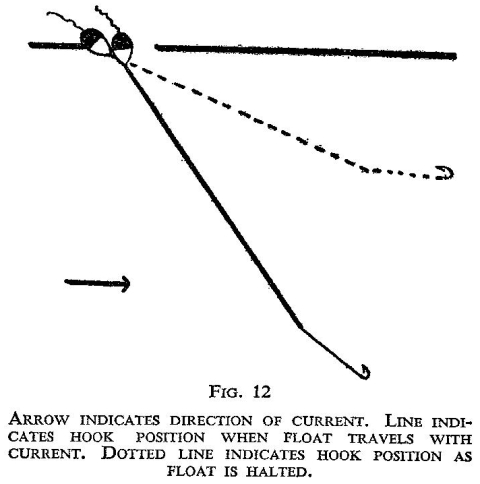
From Boats
Much that I wrote about drift lining from boats applies to float fishing. The lightest of tackle can be used, since fish can be taken in the landing net.
The boat can be anchored in such a position off rocks, jetties, buoys and other bass-attracting localities that the float will drift down to them.
One angler with whom I am acquainted anchors his boat off the shore and allows his float tackle to drift into the breakers. He does not use any weight and sets the float about four feet from the hook. This practice differs very little from drift lining in similar circumstances, but the angler claims that the float prevents the bait from being swept too far back towards the boat by the undertow as it may be in drift lining …
From Projections
When a fairly strong current flows past projections, float tackle can be used in the same way as the drift line, but the float often has at least two advantages over the drift line in this type of fishing. Around and under piers and jetties there is usually a swirl of conflicting currents and backwaters close to the piles or walls. A little experiment will show how the float can be fished so that it runs in a continuous circular or oval track, sweeping regularly in its travels close in to the framework of the projection where bass are most likely to appear as they search for food. This is the ideal way of fishing the float, for it reduces to a minimum the disturbance caused by recovering the float and its appendages. If the water is calm and clear it is desirable that the angler be hidden, but if this is impossible (as it often is in such circumstances), only essential movements should be made, and these should be made slowly.
Conditions such as these are often found in the lee of solid projections even when a strong current or a heavy sea is running.
The second advantage which the float possesses (over both drift line and paternoster) is its ability to fish a bait just off the bottom.
The ground close to projections is often fouled by objects dropped from time to time, by old wires, and by uncleared remnants of war-time defences. These make fishing with a paternoster or ledger impossible without the chance of frequent entanglements. Drift lining is not designed for near-bottom fishing in any considerable depth of water. By plumbing the depth below the projection and adjusting the float accordingly, it is possible to fish at a depth which will put the bait reasonably near the bottom, but at the same time keep it clear of obstructions. Do not forget the constantly changing level of the water.
From Rocks
Rocky ground is usually foul ground unsuited to paternoster or ledger tackle. By using a suitably heavy weight and correspondingly large float, a bait may be fished clear of underwater rocks even in a moderate current. Lighter tackle and a smaller float can be used if the tackle is allowed to drift off with the current or if the current is slight. On the lee side of the rocks, as in the case of projections, there is often an area of calm water with gentle currents moving in a circle. A very light quill float with a few split shot as weight can be used with advantage in these circumstances. The line need not be more than 5lb b.s. providing a fish can be netted or gaffed. If it has to be raised through the air a very much heavier line is needed, and this steps up everything in proportion.
When the water is clear as well as calm it is even more essential for the angler to remain concealed than in fishing from projections. Some of the bass may have become used to seeing human beings on piers. They do not expect them on lonely rocks.
"The Modern Sea Angler" (1958) Hugh Stoker at pages 62 to 67
Chapter Six
Rock Fishing
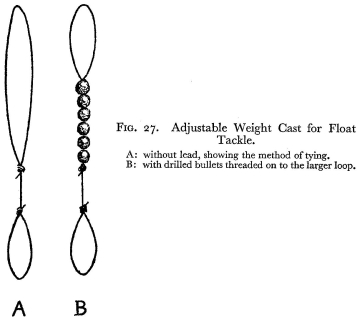
… More important, perhaps, is the kind of terminal tackle used. Bottom tackle will almost certainly become hung up and lost among the rocks, and float tackle is generally the best bet. In setting up the latter it is necessary first of all to decide how much lead will be needed to get the bait down to the required depth against the run of the tide. After this, a float should be selected which will cock up nicely under the weight of the lead, without being so buoyant as to present too much resistance to a taking fish. Far too many sea anglers are inclined to put the cart before the horse - weighting their line to suit the float, and giving no thought at all to what goes on underneath the water.
If the depth of water to be fished is greater than the length of the rod, it will be necessary to use the sliding type of float, which automatically slips down the line as the tackle is drawn out of the water. It is prevented from sliding upwards by hitching a piece of bicycle-tyre valve-rubber to the line at the point where the float is required. This flexible rubber stop should be large enough to check the float, but small enough to pass through the rod rings easily when casting or reeling in.
Many sliding floats are fitted with two small rings, through which the line is passed, and these are usually carrot-shaped. When cocked and brightly painted they are very easy to see, and are especially suitable for use as roving floats, which may be allowed to drift away for 50 yards or more on wind or tide. For casting, however, the compact egg-shaped float is more suitable; this kind usually has a hole through the centre to take the line.
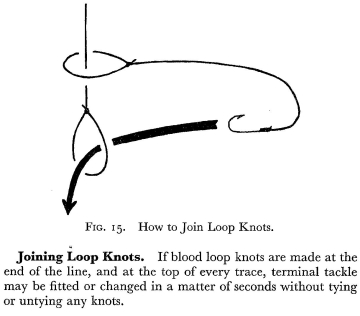
The 'bubble' type of float has made its appearance more recently than those already mentioned. Hollow, and made of transparent plastic, it is fitted with a valve so that the buoyancy of the float may be adjusted by letting in or ejecting water. It is particularly useful when fishing in sheltered water for mullet or bass.
The fairly robust kinds of float tackle normally used from exposed rocks may be weighted conveniently with quick-change spiral leads. Light celluloid floats, however, call for finer adjustment, and this is best done by making up a short cast, as illustrated below (Fig. 27), to carry a string of drilled bullets which may be added to or removed as required. The cast is looped at both ends, and may be inserted between line and hook-snood by the method of joining loop-knots illustrated at the end of Chapter Two.
The choice of hook used with float tackle will naturally depend on the size and kind of fish which frequent the locality. Mullet, which are often found around rocky coastlines, will need a small hook - something in the region of size 8. But for many other rock-haunting fish, such as bass, pollack, coalfish, and mackerel, a size 2 hook will usually prove satisfactory.
… Ground-baiting, although not widely practised among rock anglers, can be very useful for this kind of fishing. Fish-cuttings and entrails, and crushed-up crabs and shellfish, can be cast into the sea a little at a time, or lowered over the edge of the rock in a weighted net. Alternatively, the ground-bait may be spread, a spoonful at a time, on a lip of the rock, where it will be gradually washed into the sea by the advancing tide. This latter method is much favoured by mullet fishermen in the Channel Islands, where the ground-bait, known as shervy, may include finely minced horseflesh mixed with blood obtained from the local slaughter-house.
A problem arises in float fishing when the wind is blowing strongly onshore, for then one's float is apt to be returned by the sea almost as soon as it has been cast out. In some localities this puts paid to fishing altogether; but careful prospecting will often produce a rocky 'hook' or 'corner', from the end of which the wind can be used to advantage, and the line allowed to drift shorewards.
Another method, which I have used with success on exposed stretches of the Cornish coast, is to fill a bubble-float with sufficient water to render it only just buoyant. In this way there is hardly any part of the float showing above water to catch the wind, and the weight of the water-ballast makes for long casts.
Whatever tactics are employed, it is important to prevent the line from becoming slack and sinking beneath the water in a great sagging loop. When this sort of thing happens it is impossible to strike effectively when a disappearing float indicates an interested fish. Slow reeling in and repeated casting is therefore often a necessity - and results are, in fact, often improved by keeping the bait on the move in this way. Alternatively, a braided nylon line, treated with line floatant, may be used.
"Popular Sea Fishing" (1968) Peter Wheat (editor) at pages 108 to 112
The Wrasse Family (Trevor Housby)
Tackle
… During the seasons I specialized in wrasse fishing, I constantly reviewed my ideas on terminal tackle and in particular floats, which I used a great deal for wrasse. I discarded with few exceptions all the floats labelled 'sea float'. They were badly designed and far too bulky for the job in hand. Why sea floats are designed to support about 8 oz of lead with the appearance of miniature lighthouses, I cannot say, but the fact remains that many float makers still continue to produce floats which are totally unsuitable for most types of sea fishing. Long, streamlined bales or plastic floats are far superior to the standard 'bungs' which still find their way into anglers' tackle boxes. Where wrasse are concerned, the lighter and more delicate the float, the more confident will be the bite indication. A float capable of supporting 2 oz of lead is all one needs when wrasse fishing. I seldom bother to carry fixed floats, preferring the sliding variety which can be regulated to stop at the correct depth for the gully being fished.
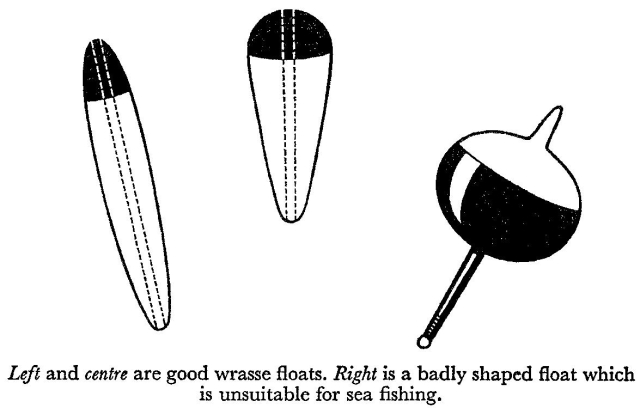
Wrasse have thick leathery mouths and once the hook is in past the barb it is unlikely to come adrift. To ensure good hook penetration a top quality make should be chosen. My personal favourites are the bronze, 'Model Perfect' eyed hooks. Before use a hook should be given a final 'edge' with a few rubs on a carborundum stone. Tackle when shore fishing for wrasse should be kept to a bare minimum. This will allow freedom of movement to cover the maximum amount of ground and so get the best from the fishing. My own kit is made up as follows: rod, reel, and shoulder bag containing a spare spool of line, a selection of sizes 2, 4, and 6 hooks, a box containing a selection of leads, sliding floats, set of scales, split shot, swivels and elastic bands for making float stops. I also take along a landing net with a telescopic handle which acts as a wading staff when crossing shallow rock gullies.
Float Fishing
Float tackle is ideal for fishing a level bottomed gully. With the bait suspended some 6 to 12 inches off-bottom it is possible to work the tackle completely round a gully, presenting the bait in a most natural manner to any wrasse feeding in the vicinity. Wrasse in feeding mood will take a baited hook in no uncertain manner, making the float abruptly vanish beneath the surface. Such bites are easily hit and very rarely is a fish missed. At odd times the float will bob up and lie flat on the surface; this is caused by a wrasse taking the bait and swimming upwards. The 'flat' float is a sure sign that the bait is well inside its mouth and a strike should be made without delay.
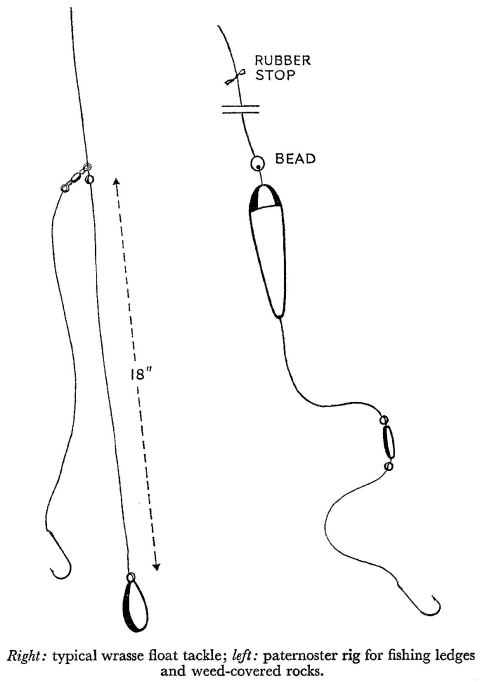
Choice of baits when float fishing is very much a matter of personal choice. My own experience leads me to believe that for all-round sport, lugworm and ragworm are best. At the same time I have proven to my own satisfaction that the average wrasse taken on worm baits is rather on the small side, and I now use them only as a stand-by. On the subject of worms, I have used garden worms quite often for wrasse and they have proved equally effective. Also, contrary to popular belief, they remain quite lively in salt water for long periods.
However, for float work I very much prefer the natural prawn. Where rocks are covered with a thick growth of weed, prawns are usually prolific and 30 minutes with a baited drop-net should produce enough of them for a full day's fishing. Collecting prawns is a simple enough job, but keeping them alive can be quite a problem. A large container is required and the water changed at frequent intervals - once it is allowed to become too stale the prawns will die in no time. A dead prawn is still quite an effective bait, though not half as successful as a live one. When using prawns alive the hook point should be passed completely through one of the tail segments. This hardly damages the prawn and allows it a high degree of movement. Prawns are absolutely perfect for wrasse, often accounting for the better quality fish - I've had several over 7 lb on this bait.
Float tackle is little use where the sea-bed is uneven. The float would need to be adjusted for depth in each section of the gully, or it would alternatively be dragging bottom, or suspending the bait well above the wrasse.
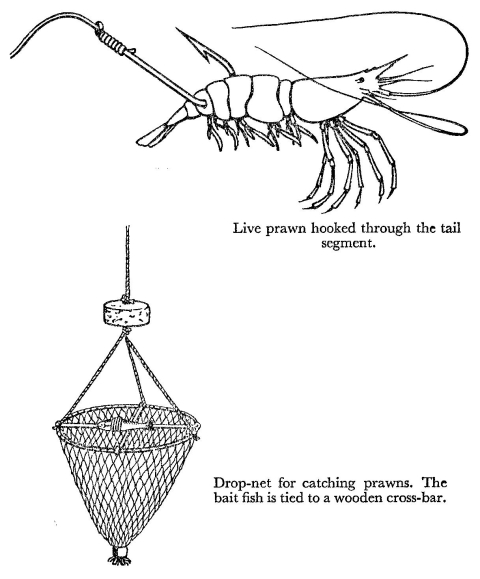
The Leger
I have tried leger tackle for wrasse on many occasions and found its suitability to be strictly limited. It works very well over sandy-bottomed weed-free areas where wrasse pick up much of their food from the bottom, but in weedy or snaggy conditions the leger frequently gets hung up and once that happens a break is an inevitable consequence. I have caught some fine wrasse on leger tackle while jetty fishing in the West Country over sand and mud bottoms.
The most practical leger weight is a ¾ oz coffin lead - the type once widely used by freshwater anglers. These weights hold the bottom well and seldom move with the action of the tide. For wrasse fishing the lead should be stopped approximately 18 inches from the hook. Worms or mussels make good baits for this style of fishing.
The Paternoster
Where wrasse are located among a jumble of ledges and weed covered rocks, the only practical type of terminal tackle to use is a paternoster. Not, I hasten to add, one of the multi-hooked steel-boomed type so popular with pier anglers! No, the wrasse pasternoster is a much more delicate affair and easily made up. The simplest way of doing this is to take a 12 inch length of monofil, tie a tiny barrel swivel to one end and a hook to the other. Pass the end of the main line through the swivel eye and run the hook length some 18 inches up the line before stopping it with a single swan shot. Finally, tie a suitable lead to the loose end of the main line.
The advantage of this tackle lies in the fact that no matter how much variation there is in depth, the bait will always be located just above the sea-bed where the wrasse mostly feed.
A good bait for this type of fishing is a hard-backed crab - about the size of a penny. These are easily collected, simple to keep and tough enough to withstand hard knocks against the rocks. To hook-on a live crab, the hook point is passed through the bait's shell from the underside so that it protrudes from the back. Mounted in this fashion a crab will stay alive and kicking for a considerable period. One other good bait worth mentioning is the common limpet.
Bites on the paternoster are usually registered by two or three sharp tugs followed by a hard pull. Wait for that final pull and rarely will you fail to hook the fish.
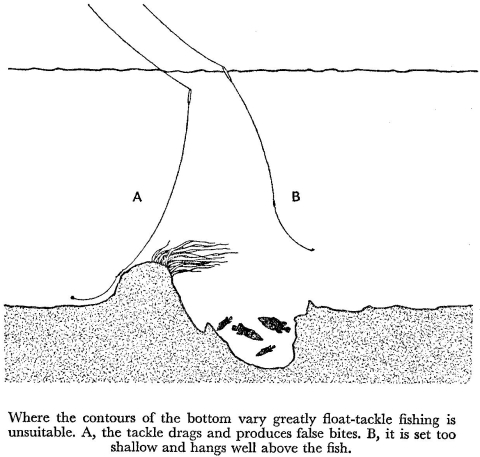
"Pelham Manual for Sea Anglers" (1969) Derek Fletcher at pages 45 & 46
Float Fishing
For sea fishing there are two main types of float in use, the sliding one and the peg type. In water of considerable depth it is advantageous to use the sliding variety which runs freely on the line until stopped by a small check tied to the line at the depth desired. The pull of the bait and weight causes the line to run through the float until the check stops it. Various methods of checking is used, a piece of rubber band, tiny split shot or a small piece of matchstick which is clove hitched to the line.
When the tackle is retrieved the float runs down the line and eventually rests on the weight when it leaves the water. If a matchstick piece is used as a check, ensure it is small enough to pass through the rod rings, but just too large to pass the wire loops of the float. Many anglers favour the use of split shot as these can be moved easily up and down the line to quickly vary the depth of fishing.
The peg-type float has rather a restricting use and one cannot fish at a depth longer than the rod for, on recovery, it will jam at the rod tip. Attached through the centre of the float is a small wooden peg which keeps the line tight.
"Estuary Fishing" (1974) Frank Holiday at pages 48 & 49
Chapter Three
Terminal Gear
Float Fishing
Float fishing is a technique used in sea fishing usually when it is desired to fish a bait above rocky ground such as in gulleys for wrasse and bass or when mullet fishing. Mullet are dealt with later; however it can be said that they demand the nearest the sea-angler ever gets to the delicate float techniques of the freshwater fisherman. Most float fishing however calls for sturdy, easily visible floats. Fluoro orange is the most visible colour. Of the various float designs I prefer the elongated egg-shaped pattern with a tube through the middle to accommodate the line. The line is stopped at the most effective depth by means of a bit of rubber band secured by a Clove Hitch. This permits ready adjustment up or down as required.
The terminal rig for float fishing is very simple and consists of no more than a suitable weight such as a small drilled bullet together with a hook. If the bait is to be live prawn or ragworm I think there is a case to be argued for using a short-shanked hook both to reduce weight and thus permit the bait more mobility and to make the presentation look as natural as possible. A 4-ounce bullet is usually about right for most locations. Having enough weight for casting this presents no problems since the float itself supplies plenty.
Float fishing in estuaries is a useful way of offering a bait when fishing over crab-infested ground. Indeed so profuse are shore-crabs in some places that this may be the only practicable way of fishing a bait. I well remember a party of Midland anglers who camped by the crab-haunted waters of an estuary and fished it expertly with heavy float tackle and accounted for a sizeable bag of flounders and school bass.
Some River Authorities controlling game-fish rivers and their estuaries enforce by-laws forbidding the use of float tackle. The idea behind this is to prevent the wholesale destruction of salmon and sea-trout parr by people trotting maggots down ground-baited pools. Whether these regulations would be applied in tidal reaches where sea fish are the quarry depends largely on whether the bailiff is convinced by the angler's explanation and his catch.
"The Guinness Guide to Saltwater Angling: Light tackle technique for British waters" (1977) Brian Harris at pages 52 & 53
3 How to use the tackle: basic techniques
… it must be pointed out that no sporting angler should venture on to any projection high off the water without carrying a big dropnet which can be lowered to the water to lift fish up. With fish weighing over 30 lb (13.6 kg) (congers for instance), a gaff on several screw-connected sweep's canes or similar, sufficient to reach the water at the lowest time of the tide, should be carried.
For float-fishing from some form of projection, the fixed-spool reel is generally first choice since casting long distances with reasonably light end tackle is easy. However, should there be no need to cast, just lower the tackle down to the water and allow it to wash around the piles of the pier, by the weedy walls of the breakwater or down the side of the rivermouth shorings, then a centrepin reel will do the job.
Sliding floats will be called for at times to fish at depths much more than the length of the rod, and these may be of balsa wood, plastic moulded, or roughly made from odd pieces of polystyrene to which is tied a small swivel through which the line can run. Sliding floats with holes lengthwise through their centres are favoured, but those with eyes fitted top and bottom are all right too. It is cheaper to make such floats at home from balsa wood of about 1 in (2.54 cm) square. This is cut into suitable lengths and drilled centrally lengthwise to take a plastic tube about a ⅛ in (3 mm) in diameter which is glued in. The float can be roughly shaped by rasp or file, then finished with varying grades of glasspaper. Several coats of paint must be put on to waterproof the body and the top is best painted with fluorescent orange over a white base.
A slim torpedo shape seems to work best and offers less resistance to a taking fish. Make or buy a selection of floats that will support lead bullets or barrel leads of ¼ - 1 oz (7 - 28 g). There are a number of ways to stop the float on the line at the required depth and yet still permit the stop to travel from the reel and through the rings of the rod without any impediment. But perhaps the best is a length of elastic band about ⅜ in (1 cm) tied into the line at the selected point with a clove hitch or similar knot that will pull out once the elastic is removed.
200 Sea Fishing Tips (1982) Ivan & Ivor Garey Tips 49 & 50
7. Floats
49. Casting floats
The recent development of special floats, originally intended only for catching garfish, has made it possible to fish far from the shore for other kinds of fish as well, especially species which occasionally swim at high levels, such as bass, mullet, shad, mackerel and horse mackerel. With these floats it is even possible to fish for flatfish in shallow water, a very successful method of fishing which is rapidly becoming popular …
50. Long-distance casts
Up to a few years ago the various plastic casting floats available enabled us to cover 30 - 40m. The insurmountable problem was that because of their lack of stability these floats twisted in flight and tended to spin down. The introduction of the Stabilo float has solved the problem of twisting, with the result that very long casts can now be made … The average sea angler should certainly be able to cover 70m and at that distance from the shore there are plenty of fish.
"New Angler's Mail Guide to Sea Fishing" (1989) Chris Clark at pages 77, 78 & 79
Flounder Rig
First slide on a 4AAA Avon float before tying a small swivel to the end of the reel line. This prevents the flatties from spinning in the tide and twisting the line. Attach a hook link of 5lb line to the swivel and tie on a size 2 or 4 fine wire Aberdeen. The float is set at just the right depth so the hook nudges bottom. That way it will stir up the mud as it drifts down on the tide and hopefully prove even more attractive to the inquisitive flounders. My preferred shotting pattern to achieve this effect is shown in the (flounder front rig) diagram above. Please note the pair of shot fixed just above the hook which will help disturb the bottom mud.
Where to fish
A deep-water channel in a river estuary [1] which runs near the shoreline is the sort of flattie mark which responds to a float if there's a fair run of tide. Just flick the float out a few yards and let it trundle along in the flow. A bite is often signalled by the float stopping dead but you should also strike at any sidewards movement. Flounders are not known for their fighting qualities but on light float tackle they're fair scrappers.
[1] Such as the Stour in Pegwell Bay
Mullet Rig
The scaled down end rig for mullet reflects the shy biting reputation of this species. There is no need for a swivel while a size 8 or 10 hook is tied directly to the main line. The bottom shot should be at least 12in above the hook as indicated with the rest of the shot spaced out at intervals of 6in.
Sometimes mullet feed very deep down in the water alongside breakwaters and harbour walls and that is a job for the slider.
The smaller Drennan Pikers are handy for this task. A stop knot is tied at the correct depth and it should be adjusted during the session until you are able to find the correct level at which the fish are feeding.
Attracting mullet
Top baits are probably bread and maggots. To really attract mullet in numbers, hang a small mesh sack filled with bread that has been soaked in pilchard oil a couple of feet below the surface. Particles will filter out with the tide and maintain the mullets' interest.
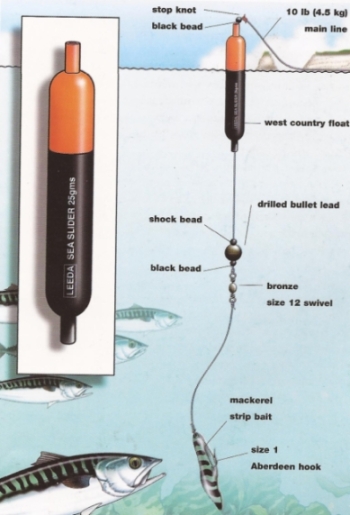
"Salt-Water Fishing: A Step-by-Step Handbook" (2006) Martin Ford & Bruce Vaughan at page 51
Shore Fishing
General Float Fishing
Mackerel and garfish are two favourite targets for the float angler, especially during the summer. A pier rod, or better still a freshwater carp rod, can be used in conjunction with a small fixed-spool reel holding 8 - 10lb (3.63 - 4.54kg) line. Fishing with light, balanced tackle like this will maximize sport from the powerful fighting mackerel and the acrobatic garfish. Setting a medium-sized float at a shallow depth of say 4ft (1.22m) is a well-practised method for mackerel. The float is fixed to the line by first threading the line through a stop bead. The stop bead will slide up to a stop knot of power gum or an elastic band set at the depth required. A float is then put on the line by passing the line up through the centre of the float. Another bead is placed under the float and under this a ball lead, heavy enough to cock the float, is positioned. Another bead is placed under the weight and then a swivel is tied on to the line. To this swivel a 12in (30cm) length of line is tied and a size 1 Aberdeen hook is tied at the bottom end. Bait the hook with a strip of sandeel or even mackerel and you should catch a good quantity of these fish should there be any in the immediate area.
Where there are mackerel the sea angler is also likely to encounter garfish. The garfish tends to feed on, or near, the surface, and it often pays to fish one bait below the float and one bait above it. Using the same setup described for the mackerel, simply add a separate snood above the float. The baited hook on this snood will sink just below the surface and will sit in prime position for the shallow-feeding garfish. For other species, such as pollack and wrasse, the float is usually a bit larger, and only one hook is used. The only difference is that it is fished at a deeper depth and different baits are used. When fishing for wrasse from the rocks or pier, try baiting up the hook with a whole softback crab. The smaller the crab the better as it will allow better hooking. For pollack or coalfish a ragworm bait is preferred, especially if you are fishing at night from the pier.
"A Fresh Approach" (2008) Wayne Thomas, Guide to Angling in South West England
Light float fishing … Mention the use of freshwater tackle on the coast and many will automatically think of grey mullet. These hard fighting fish are prolific all around our coastline during spring, summer and autumn. They can be caught using light float tackle or quiver-tip tactics. A twelve-foot float rod in conjunction with 6lb line, a chubber or Avon style float, size 8 to 10 hook and a pinch of bread flake will bring success. Harbours, rocks and piers are ideal venues where the application of ground-bait will entice not just mullet but garfish, pollack, mackerel, and even black bream. In addition to float-fishing a cage feeder packed with breadcrumb with a two hook paternoster baited with bread flake will provide excellent sport. A quiver tip rod designed for barbel is ideal.
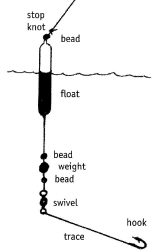
"Go Sea Angling" (2010) Mario Massimino at page 18
Rigs
Sliding Float Rig
Float fishing must be one of the most exciting ways to fish, watching the float bob and disappear as the yet unseen fish takes the bait.
Firstly thread a bead on the main line, followed by the float, bead, weight, another bead and then tie on a swivel, taking care not to let go or else everything you have just put on will fall off again.
Now tie a piece of line onto the other end of the swivel - this should be between 12 to 18 inches long (the trace) and attach the hook.
Now tie a stop knot onto your main line. This can be moved up and down to adjust the depth at which you are fishing.
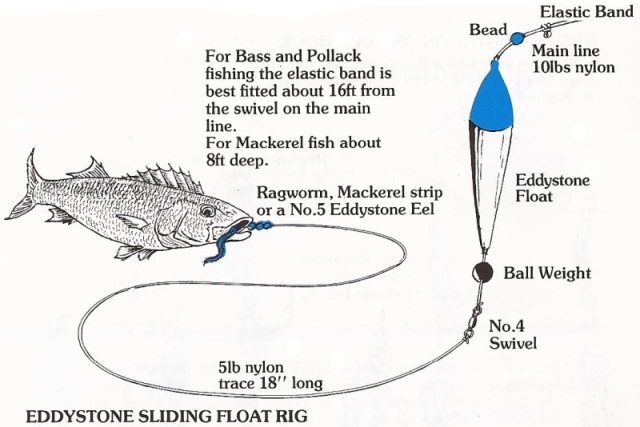
"Hooked on Sea Angling" (2011) Martin & Dave Beer